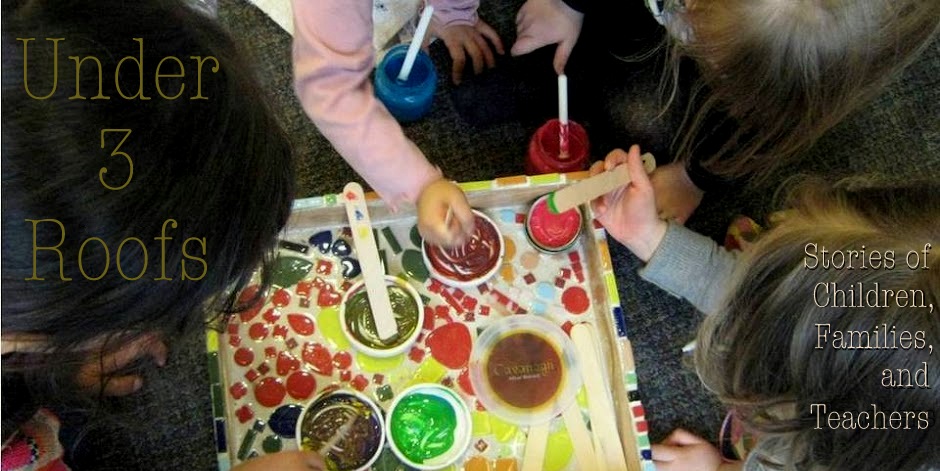What is a “loose part”?
Loose parts are essentially materials that can be moved
around and manipulated in many ways, and which don’t necessarily have a single
assigned “job” or use.
Why should we play with them?
In the 1970s, the Theory of Loose Parts was developed by
architect Simon Nicholson in response to what he saw as a lack of opportunity
for children (and adults outside the realms of architecture) to play around
with concepts of building and construction in their daily lives. The principle
of the theory is as follows:
“In any environment, both the degree
of inventiveness and creativity, and the possibility of discovery, are directly
proportional to the number and kind of variables in it.”[1]
In other words, when people interact in a given space, the more options they are offered, and the more the available options can be combined and recombined, the more
interesting and diverse the results.
The repercussions of this idea for the early childhood classroom are clear – when we offer children more materials that are unscripted, hold multiple
possibilities, and can be put together and taken apart in numerous ways
we see more creativity, engagement, and discovery on the part of
students (and I would argue on the part of the teachers and parents as well!).
And these benefits are not limited to the realm of building and spatial
thinking, but can extend far beyond, into the realms of dramatic play, artistic
expression, literacy , and mathematical thinking… to name a few.
Below are just a few
instances of children at work with loose parts in our center. Where do you see inventiveness and creativity at work through these
materials?
Tubes of varying sizes
inspire Alec and Grace to investigate stacking them and trying to fit them
inside each other. Grace tried to cover one long tube with several smaller ones, while Alec tried to see if he could nest two tubes of the same size.
Atom discovers that these small plastic containers stack one on top of the other very nicely. He builds a tower, taller, taller, taller, until it begins to wobble. When it falls down - crash! - he picks up the pieces and begins to build again.
J and F investigate the structural integrity of this "house" made of carpet squares. It was able to hold several heavy blocks for its "roof" before it finally collapsed.
Julius and Quinn examine a tube stuffed with mylar together. The mylar is crinkly, sparkly, and noisy, and the tube is tricky for small hands to manipulate. It rolls and tips as they try to angle it just so, searching for the best way to look in and pull out the mylar.
Leon and Cathy found some pieces of sheer fabric in the movement studio while they watched a projection of some Riverdance performers. They used the fabric as costumes, as something to hide behind, and, finally, as something to hold behind their backs, the same way some of the dancers held their hands behind their backs.
Jihye and Emmett discovered a wooden place-mat and a piece of bumpy, translucent plastic in the Studio. Looking through them, they noticed that their view of the world changed! The other children in the Studio also noticed that it changed the way Jihye and Emmett looked, making it hard to see all of Jihye's face, and making Emmett look "foggy."
[1]Nicholson, S (1972). The Theory of Loose Parts: An important principle for design methodology. Studies in Design EducationCraft & Technology 4, (2), 6.
J and F investigate the structural integrity of this "house" made of carpet squares. It was able to hold several heavy blocks for its "roof" before it finally collapsed.
Julius and Quinn examine a tube stuffed with mylar together. The mylar is crinkly, sparkly, and noisy, and the tube is tricky for small hands to manipulate. It rolls and tips as they try to angle it just so, searching for the best way to look in and pull out the mylar.
Leon and Cathy found some pieces of sheer fabric in the movement studio while they watched a projection of some Riverdance performers. They used the fabric as costumes, as something to hide behind, and, finally, as something to hold behind their backs, the same way some of the dancers held their hands behind their backs.
Jihye and Emmett discovered a wooden place-mat and a piece of bumpy, translucent plastic in the Studio. Looking through them, they noticed that their view of the world changed! The other children in the Studio also noticed that it changed the way Jihye and Emmett looked, making it hard to see all of Jihye's face, and making Emmett look "foggy."
[1]Nicholson, S (1972). The Theory of Loose Parts: An important principle for design methodology. Studies in Design EducationCraft & Technology 4, (2), 6.






